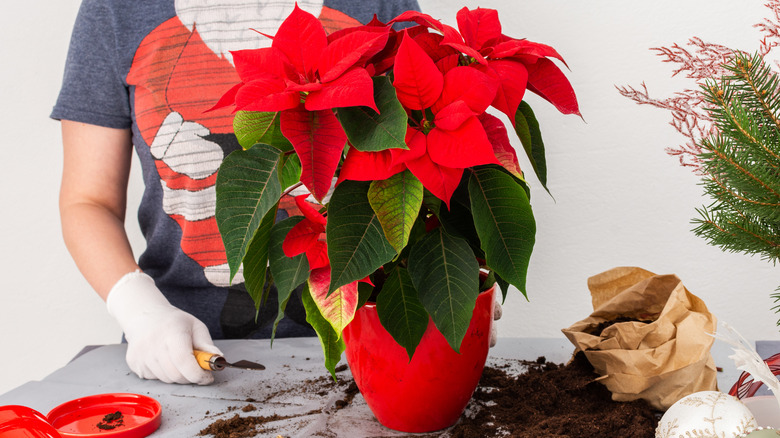Poinsettias are tropical plants that many people buy to keep as houseplants, especially over the winter holiday period. They bloom in December and January, adding a welcome splash of color, however, they can be kept alive all year with some special care during their dormant season in autumn. Keeping them healthy with careful watering practices, repotting as needed, and adding amendments to the potting soil, will keep poinsettias healthy year-round. One excellent addition to the soil, which is practically free from your kitchen, is used coffee grounds.
Many gardeners and plant enthusiasts are familiar with the usefulness of used coffee grounds as a soil amendment. Used coffee grounds improve drainage and add nutrients that attract earthworms. Coffee grounds can also make the soil pH slightly more acidic, making it nourishing for many plants. Poinsettias prefer slightly acidic soil, so coffee grounds are an excellent soil amendment choice. It’s easy to use coffee grounds — they can be mixed into potting soil or garden soil. For your poinsettia, your main consideration when using coffee grounds is choosing the right time.
When to add coffee grounds to poinsettia soil

Poinsettias have particular needs to keep them thriving during different times in their growth cycle. The timing for adding soil amendments, including coffee grounds, should roughly follow the guidelines for when to fertilize your poinsettia. So coffee grounds should be added when the blooming season is over, and before it starts forming new buds. This means that you should add coffee grounds to your poinsettia’s soil sometime between late April and early September.
Ideally, you should add amendments at the same time you do any pruning, which is also best done after the blooming season. As long as these tasks are done by early September, your poinsettia should be fine. However, it is also recommended to place your poinsettia outside (out of direct sunlight) for the summer months, so for the sake of efficiency, the pruning and soil amending are best done before you move the poinsettia to its summer location.
The reason to avoid adding coffee grounds to your poinsettia’s soil during its dormant period (mid-September through December) is that it needs time to rejuvenate and store energy to form new growth for the bloom cycle. While the poinsettia is “blooming” (when the green leaf bracts have turned red from December through April) it still has all the nutrients it needs, so extra amendments aren’t necessary.
How to add coffee grounds to poinsettia soil
There are several ways to add used coffee grounds to the soil. You can mix in some used coffee grounds with the potting soil to be added when you plant or repot your poinsettia. Mix the coffee grounds in thoroughly as you would other amendments such as sand or peat moss. Then add the amended soil to the container when you plant or repot your poinsettia. If your poinsettia is growing outside in the ground, you can use a trowel or hand spade to work some coffee grounds into the top layer of soil surrounding it. You can also add used coffee grounds to the hole you dig before planting it as a soil amendment to give it a good start.
Give your poinsettia a light drink of water after adding the amendments, after that wait until the top layer of soil is dry to the touch before watering. For poinsettias in containers located either indoors or outdoors, you can also add a light layer of coffee grounds to the top layer of soil in the container. Gently mix the coffee grounds into the top two inches of potting soil with a small trowel or spoon.